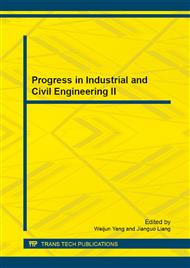p.511
p.521
p.527
p.535
p.541
p.548
p.554
p.558
p.562
A Mechanism for Loess Self-Load Collapsibility-Saturated Loess Liquefaction Caused by Earth Microtremors
Abstract:
This paper presents a new mechanism for loess self-load Collapsibility-saturated loess liquefaction caused by earth microtremors .The principle of earth microtremors is briefly introduced and the processes of saturated loess liquefaction induced by earth microtremors are analyzed from a dynamic view. A field test of loess in water immersion was done over a 420 hour period on Gaolanshan Mountain at Lanzhou,China. After stopping water flooding, earth microtremors at the bottom of test impounding pits were continuously measured by seismic equipment.We conclude that there is a relationship between loess collapsing values and the amplitude and predominant period of the earth microtremors.The results of our study show that the higher the amplitude and the longer the predominant period of earth microtremors, the more intensive will be the liquefaction grade.Finally,then most probable series of affecting factors to liquefaction,such as C. values of loess,amplitude, frequency, duration,wave type and propagation direction are all favorable to loess liquefaction.
Info:
Periodical:
Pages:
541-547
Citation:
Online since:
September 2013
Authors:
Keywords:
Price:
Сopyright:
© 2013 Trans Tech Publications Ltd. All Rights Reserved
Share:
Citation:


